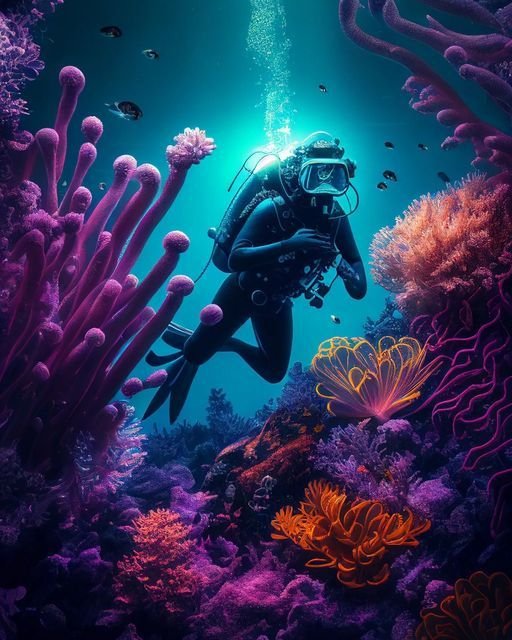Introduction: The Language of the Ocean
Beneath the ocean’s waves lies a world filled with sound, color, and light — a silent symphony that humans are only beginning to understand. For centuries, people believed the deep sea was a quiet, lifeless realm. But as technology advanced, scientists discovered that the ocean is alive with communication. From the haunting songs of whales to the crackling of shrimp and the pulsing lights of jellyfish, sea creatures have developed remarkable ways to “talk” to one another. This underwater language is as complex and diverse as the ocean itself, revealing the intelligence and adaptability of marine life.
Sound as the Ocean’s Universal Language
In the underwater world, sound travels faster and farther than in air — nearly four times faster. Because light fades quickly in the deep, marine animals rely heavily on sound to navigate, hunt, and communicate. Whales, dolphins, fish, and even invertebrates have evolved unique acoustic signals suited to their needs. For example, the low-frequency calls of blue whales can travel hundreds of kilometers across the open sea, allowing them to stay in touch over vast distances. In contrast, dolphins use high-pitched clicks and whistles for short-range communication and echolocation.
The Songs of Whales: Nature’s Ocean Orchestra
Whales are among the most famous communicators in the ocean. The humpback whale is known for its long, melodic songs that can last for hours and be heard over great distances. These songs are not random noises — they have structure, rhythm, and repetition, much like music. Scientists believe humpback songs play a key role in mating, helping males attract females and establish dominance. Other whale species, such as blue whales and fin whales, produce deep, resonant calls used for long-distance communication. These vocalizations can travel across entire ocean basins, connecting individuals separated by hundreds of miles.
Dolphin Conversations: Whistles, Clicks, and Names
Dolphins are often called the “talkers” of the sea due to their complex and intelligent communication systems. They use a combination of clicks, whistles, and body movements to share information. One of the most fascinating discoveries about dolphins is that they use signature whistles — unique sounds that function like names. Each dolphin develops its own whistle and recognizes the calls of others, allowing for individual identification within pods. Dolphins also use echolocation clicks to navigate and hunt, emitting sound waves that bounce off objects and return as echoes, giving them a detailed image of their surroundings.
Fish with Voices: Grunts, Croaks, and Drums
While whales and dolphins often steal the spotlight, fish are surprisingly vocal too. Many species produce sounds by rubbing body parts together or using specialized muscles that vibrate their swim bladders. The toadfish, for example, emits a “boatwhistle” sound to attract mates, while the black drum fish gets its name from the drumming noise it makes during mating rituals. Even coral reef fish use sound to defend their territories and warn of predators. Although their calls may not travel as far as whale songs, they create a lively underwater chorus that scientists continue to study.
Crustaceans and Snapping Shrimp: The Ocean’s Noisiest Residents
One of the loudest creatures in the sea is surprisingly small — the snapping shrimp, also known as the pistol shrimp. These tiny crustaceans produce sound by snapping their claws shut at incredible speed, creating a shockwave that stuns prey and produces a sharp “pop” louder than a gunshot. In coral reefs where snapping shrimp live in large numbers, their collective snaps create a constant crackling noise that can mask other sounds. This acoustic camouflage benefits both the shrimp and other species that rely on sound for communication.
Visual Communication: Colors and Patterns in the Sea
Sound isn’t the only way sea creatures communicate. Many species use visual cues — from color changes to body movements — to express emotion, signal danger, or attract mates. The cuttlefish, a close relative of the squid and octopus, is a master of visual communication. It can rapidly change its skin color and texture to send messages, blend into its environment, or intimidate rivals. Similarly, the mandarinfish uses its bright, iridescent colors to attract mates during its evening courtship dances. These displays are not just beautiful but vital for survival and reproduction.
Bioluminescence: Light as a Language
In the dark depths of the ocean where sunlight never reaches, many creatures rely on bioluminescence — the ability to produce light through chemical reactions. This natural glow serves as a form of communication. Some deep-sea fish flash light to attract prey or mates, while others use it to confuse predators. The lanternfish uses rows of light-producing organs called photophores to signal its presence to others of its kind. The firefly squid in Japan performs a mesmerizing light show during mating season, turning coastal waters into a sea of blue. These luminous signals are an elegant example of evolution’s creativity in adapting communication to extreme environments.
Chemical Communication: Scent Signals in the Water
Not all communication in the ocean involves sight or sound — some creatures rely on chemical signals to share information. Many species of fish, mollusks, and crustaceans release pheromones to attract mates or mark territory. For example, lobsters use chemical cues during mating to indicate readiness and social status, while some reef fish detect chemical changes in the water to sense nearby predators. Chemical communication is especially important in murky waters or the deep sea, where visual and acoustic signals may not travel far.
Touch and Movement: The Language of Contact
For many marine species, touch and movement are also essential forms of communication. Dolphins rub bodies as a sign of affection or reassurance, while sharks engage in contact behavior during courtship. Sea turtles communicate through gentle nudges and movements, particularly during mating season. Even schooling fish coordinate their movements with astonishing precision, relying on tiny sensory organs called lateral lines to detect changes in water pressure. This allows thousands of individuals to move as one, avoiding predators and navigating complex environments.
The Role of Silence: When Sound Disappears
Interestingly, silence can also be a form of communication in the ocean. Some species stop making noise when predators are nearby, reducing their chance of detection. Scientists studying reefs have found that a healthy, bustling reef sounds completely different from a damaged one — a thriving reef hums with life, while a dead reef is eerily quiet. This loss of natural sound is a warning sign of environmental decline, serving as a reminder that the ocean’s health can often be heard as much as it can be seen.
The Human Impact on Ocean Communication
Unfortunately, human activities are increasingly disrupting the ocean’s acoustic world. Noise pollution from ships, sonar, drilling, and construction interferes with marine communication. Whales, dolphins, and other sound-dependent species can become disoriented, unable to find mates, locate food, or navigate migration routes. The loud noises produced by naval sonar have been linked to strandings of deep-diving whales. To protect marine life, conservationists are advocating for quieter ocean technologies and the creation of marine protected sound zones where human noise is limited.
Technology Inspired by Marine Communication
Scientists are studying how marine animals communicate to develop new technologies. For example, dolphin echolocation has inspired sonar systems and underwater communication tools used by submarines and robots. The patterns of fish schools have influenced the design of swarm robotics, where machines move together like a coordinated group. Even the chemical communication systems of marine organisms are being studied for applications in medicine and environmental monitoring. Nature’s ingenuity continues to inspire innovation and deepen our understanding of how life connects through communication.
The Future of Understanding Underwater Communication
Research into underwater communication is still in its early stages. New listening devices and hydrophones are allowing scientists to monitor the “soundscape” of the ocean more effectively. Through these technologies, we can detect patterns of communication, migration, and even stress in marine populations. By decoding the language of the sea, researchers hope to create better conservation strategies and deepen humanity’s connection with the ocean. Understanding how marine life communicates is not only a scientific goal but also a step toward protecting the fragile ecosystems that sustain it.
Conclusion: The Ocean Speaks — Are We Listening?
The ocean is far from silent. It is a world full of voices — clicks, songs, pulses, and flashes — each telling a story of survival, love, and life. From the haunting songs of whales to the delicate light of bioluminescent creatures, underwater communication is one of nature’s greatest wonders. It reveals intelligence, emotion, and social connection in species once thought to be primitive. As we continue to explore the ocean, we must learn to listen — not just with our instruments, but with curiosity and respect. The sea speaks in many languages, and each whisper reminds us that we are part of a living, communicating planet.


